Key takeaways:
- Cloud storage provides key advantages such as accessibility, collaboration, automatic backups, and cost-effectiveness compared to local storage.
- Choosing a cloud provider requires careful evaluation of features, security, customer support, and scalability to avoid limitations in the future.
- Transitioning to the cloud increases productivity and reduces costs associated with hardware maintenance, unexpected repairs, and lost time on backups.
- To optimize cloud usage, regular management of files, understanding provider features, and implementing robust security measures are essential.
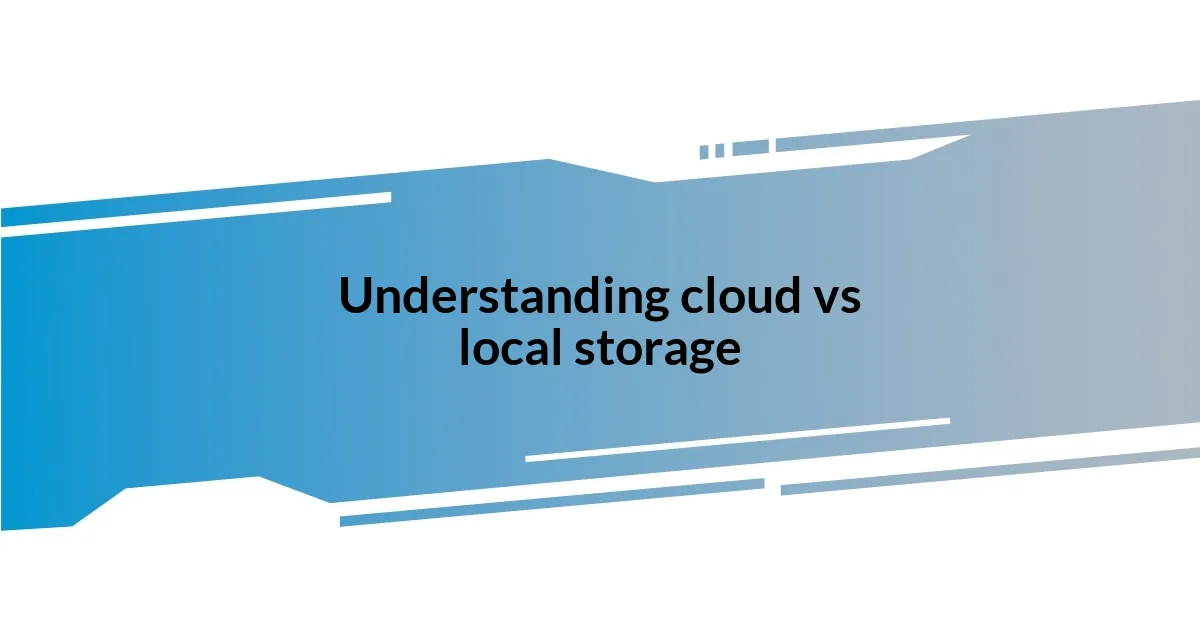
Understanding cloud vs local storage
When I first explored the differences between cloud and local storage, I was struck by how each option has its unique strengths and weaknesses. Cloud storage offers convenience and accessibility from anywhere, which was a game-changer for my collaborative projects. The idea of being able to share large files effortlessly with my team while knowing they were safe on a remote server was incredibly reassuring.
In contrast, local storage felt like a more tangible choice, as my files were physically right there with me on my hard drive. I remember the anxiety I felt during a power outage when I was working on an important presentation; I couldn’t help but wonder if my recent work was fully saved. This experience really made me question whether the sense of security I had with local storage was more of a comforting illusion rather than a rational choice.
Yet, thinking about it further, I realized that relying solely on local storage could leave me vulnerable to hardware failures or accidental deletions. Have you ever lost a crucial file because your hard drive failed? It’s a nightmare I don’t wish to relive. The beauty of cloud storage, with its automatic backups and version control features, offers a level of protection that has become vital in my digital life.
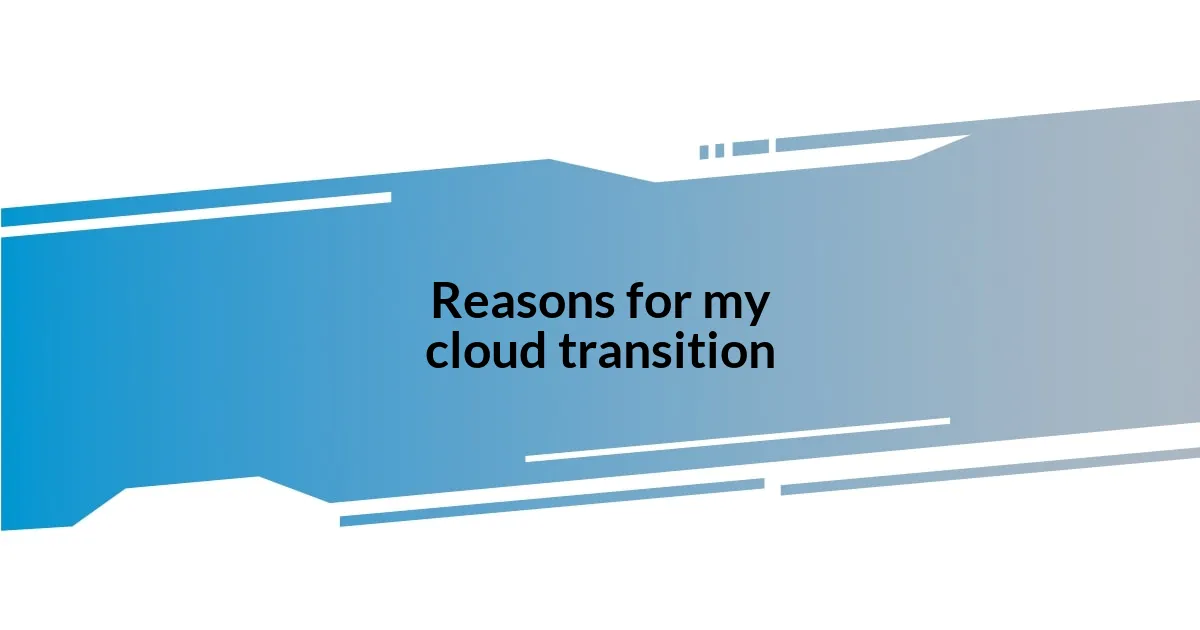
Reasons for my cloud transition
Once I delved deeper, one compelling reason for my transition to cloud storage emerged: the ability to access my files from anywhere. Picture this: I was at a coffee shop, eager to work on my presentation, but I realized I left my USB drive at home. Thankfully, with cloud storage, I could simply log in and access everything I needed right from my laptop. That moment solidified my belief in the cloud’s convenience and flexibility.
Here are some key reasons that drove my decision:
- Accessibility: I wanted to work seamlessly from multiple devices and locations.
- Collaboration: Sharing files with my team became a breeze, enhancing our workflow.
- Backup Assurance: Knowing my files were automatically backed up provided peace of mind in case of emergencies.
- Cost-Effectiveness: I found cloud storage options that fit my budget without compromising on features.
- Automatic Updates: I no longer had to worry about outdated software; the cloud handles that for me.
This blend of practicality and security has not only improved my workflow but transformed how I manage my digital life.
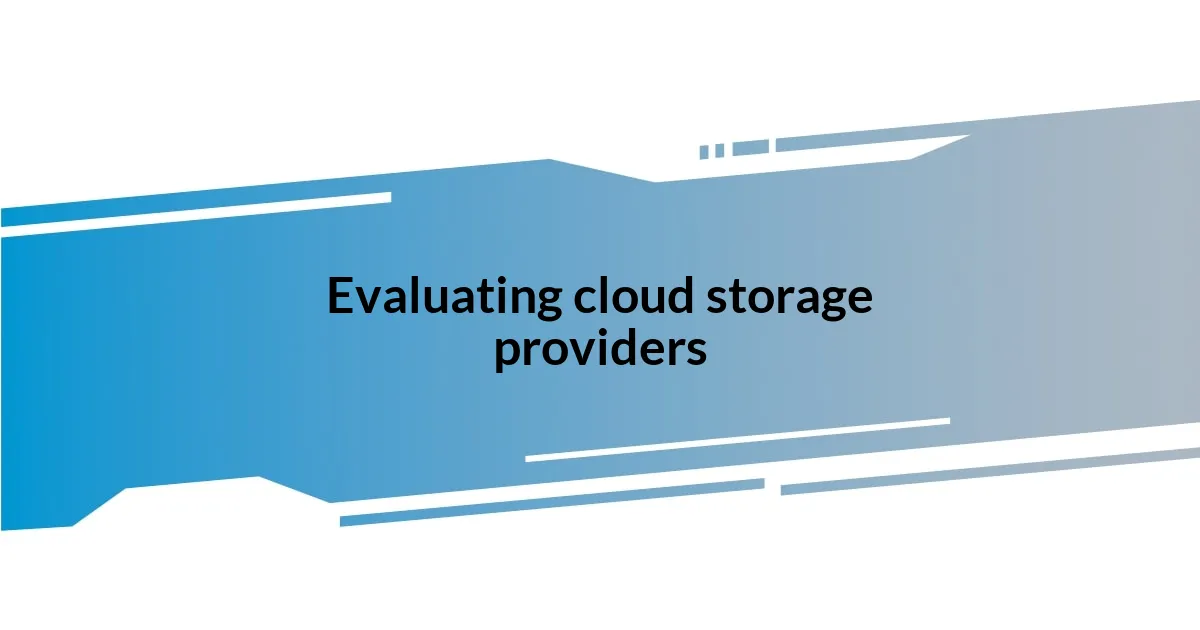
Evaluating cloud storage providers
Evaluating cloud storage providers requires considering several critical factors. From my experience, I’ve found that price isn’t everything; a slightly higher cost can translate into better security features or customer support. For instance, I once chose a provider solely based on its low price and quickly learned the hard way that their lack of responsive customer service left me hanging when I needed support for a data recovery issue.
Then there are the features that often distinguish providers. A few years back, while transitioning to cloud storage, I was impressed by the collaboration tools offered by one provider. My team was able to work on documents in real time, eliminating the back-and-forth email chains that used to plague our projects. I realized that such functionality was worth any additional investment, as it significantly improved our productivity.
Lastly, don’t underestimate the importance of storage capacity and scalability. I once faced a dilemma when my initial choice limited me to a fixed amount of space. As my projects expanded, I quickly outgrew those limits and scrambled to find a new solution. A provider that offers scalable options ensures that as your needs change, you won’t have to deal with another frustrating migration process.
| Provider | Features |
|---|---|
| Provider A | Advanced security, real-time collaboration |
| Provider B | Affordable, limited support |
| Provider C | Scalable storage, excellent customer support |
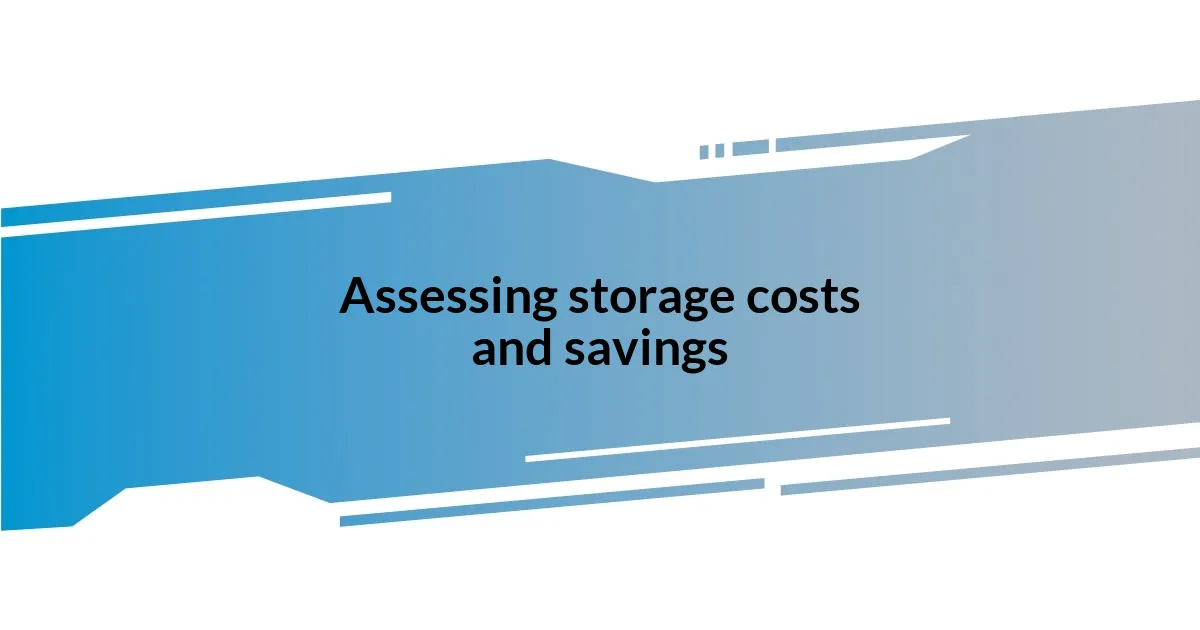
Assessing storage costs and savings
When I first started evaluating storage costs, I was genuinely shocked by how much money I was pouring into local storage solutions. The prices add up—think about hardware costs, maintenance, and even the electricity to keep those servers running. I started to ask myself, “Is this truly worth it?” Given the flexibility of cloud storage, I quickly realized I could use that budget toward more productive endeavors.
One key saving I discovered was not just in initial costs, but also in avoiding those unexpected expenses. For example, after upgrading my local server, I found out that I needed to shell out extra cash for repairs due to unplanned downtime. Feeling both frustrated and financially strained, I began to see cloud solutions as an opportunity to prevent these sudden drains on my budget. The consistent monthly fees make it much easier to plan and allocate my resources, helping me sleep a little better at night.
As I crunched the numbers, I realized the savings went beyond mere dollars and cents. The time I lost dealing with hardware issues and backups was invaluable. Think about it: what’s your time worth? For me, transitioning to the cloud meant reclaiming hours I could spend on more impactful projects. This realization solidified my choice; investing in the cloud wasn’t just a cost but a way to ultimately enhance productivity and mental clarity.
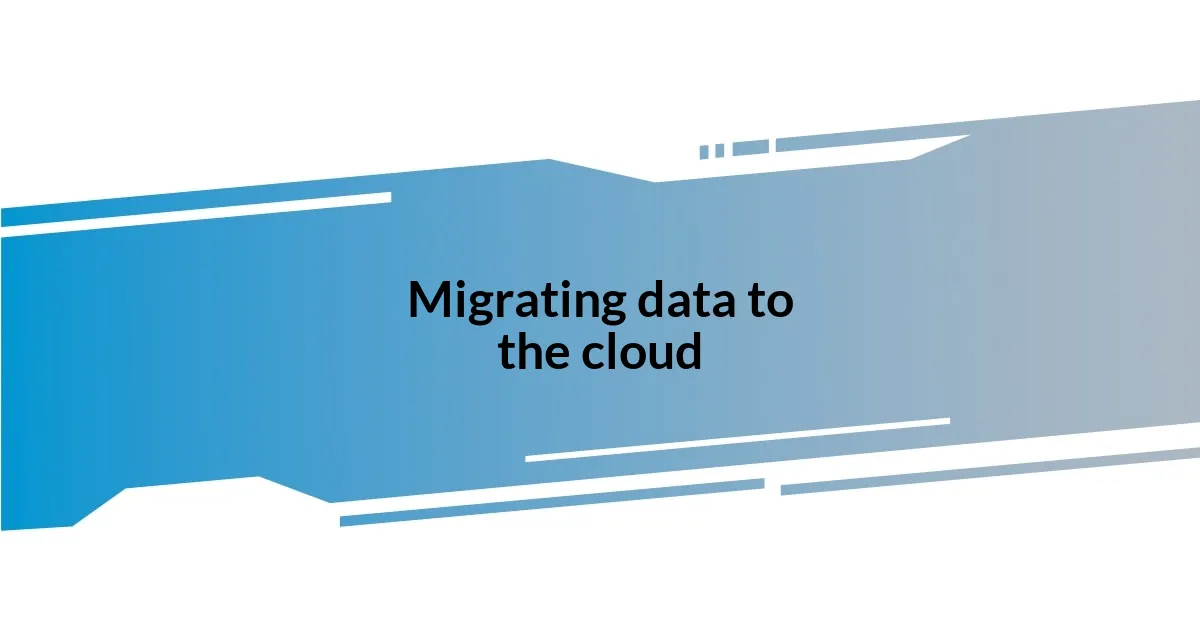
Migrating data to the cloud
Migrating data to the cloud can feel overwhelming, but it’s a journey worth taking. I recall the moment I started the actual transfer of files; I felt a mixture of excitement and anxiety. What if something went wrong? Determined to mitigate that fear, I meticulously planned my migration in stages, starting with less critical files to test the waters.
During this process, I discovered the importance of backup protocols. Initially, I didn’t consider creating extra copies of my data before migrating. However, after a minor hiccup that caused a file to become corrupted, I learned my lesson the hard way. Now, I always recommend having a secondary backup—whether it’s another cloud service or an external hard drive—just in case.
When I finally completed the migration, it was a bittersweet moment. I felt relief mixed with nostalgia, saying goodbye to my old hardware. Yet, that switch marked a new beginning. With every gigabyte that moved to the cloud, I could feel my stress dissipating, replaced by a sense of freedom to access my files from anywhere. Isn’t that what we all desire—a seamless way to work without the heavy burden of managing physical storage?
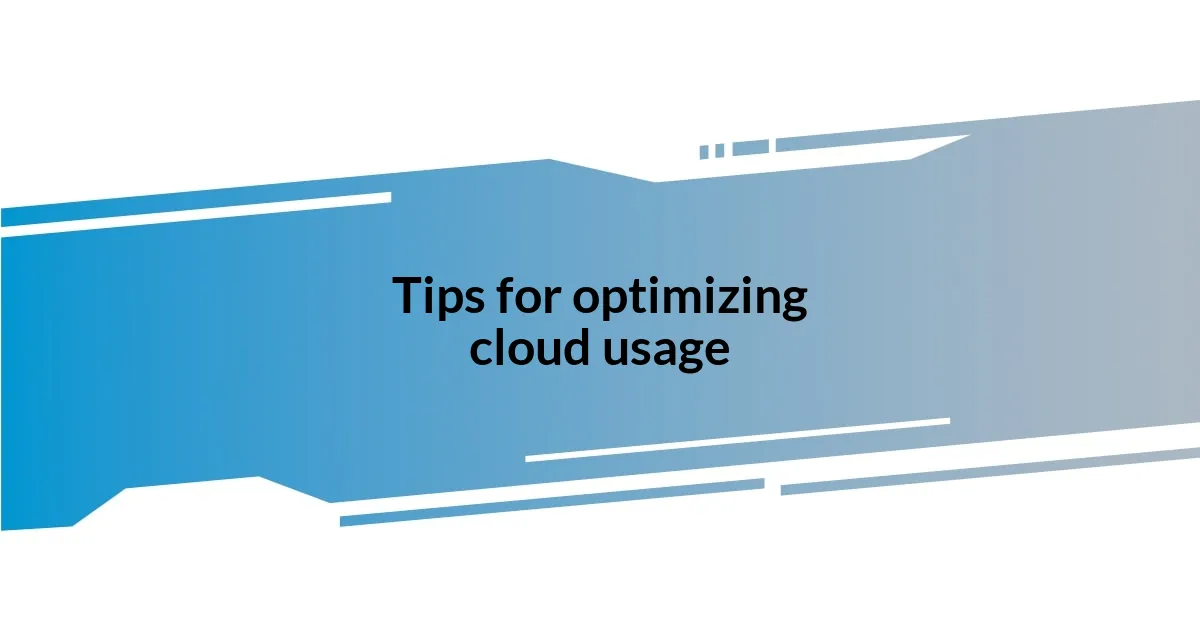
Tips for optimizing cloud usage
To truly optimize my cloud usage, I focused on understanding the various features offered by my cloud provider. I remember feeling a bit lost at first, but taking the time to explore functionalities like automatic backups and file sharing transformed my experience. Have you ever stared at a dashboard and wondered, “What am I even looking at?” Diving into tutorials and support forums helped me unlock capabilities that significantly improved my workflow.
Another crucial tip is to regularly review and manage your cloud storage. I’ve found that files can pile up quickly, and it’s easy to forget what’s even in there. I set a reminder every few months to sift through my stored data, deleting anything outdated or unnecessary. Ask yourself, “Is this file truly serving a purpose?” You’ll be surprised at how much unnecessary clutter you might remove, freeing up valuable storage space and, more importantly, mental bandwidth.
Lastly, I can’t stress enough the importance of security. After learning about a data breach incident with a company I trusted, it sparked a sense of urgency about protecting my own information. I took steps to implement two-factor authentication and regularly updated my passwords. It’s a small effort that adds an incredible layer of protection—peace of mind is worth its weight in gold, isn’t it? Secure cloud storage means I can focus more on my projects and less on potential data mishaps.